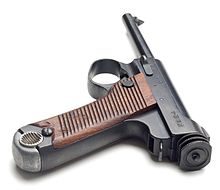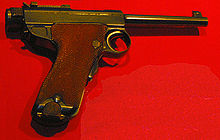- Nambu pistol
-
Type 14 Nambu 
Nambu Pistol Model 14 (1925)Type Semi-automatic pistol Place of origin  Empire of Japan
Empire of JapanService history In service 1906-1945 Used by See Users Wars Second World War, Second Sino-Japanese War, Chinese Civil War Production history Designer Kijiro Nambu Designed 1902 Produced 1906 - 1945 Number built 10,300 (Type A, all variants)
279,000 (Type 14)Variants Type 4, Type 14 Specifications Weight 900 g (1.98 lb) unloaded Length 230 mm (9.06 in) Barrel length 117 mm (4.61 inches) Width 720 g Cartridge 8x22mm Nambu,7x20mm Nambu Caliber 8 mm Action recoil-spring Muzzle velocity 950 ft/s (289.6 m/s) Effective range 50 m Feed system 8 round box magazine The Nambu pistol (南部拳銃 or 南部大型自動拳銃 Nanbu kenjuu or Nanbu ōgata jidou-kenjuu) was a semi-automatic pistol used by the Imperial Japanese Army and Navy during the First and Second World Wars. The pistol had two variants, the Type A (also called the Type 4), and the Type 14 (南部十四年式自動拳銃).
Contents
History
The origins of the pistol go back to the design by General Kijiro Nambu in 1902. He was a prolific arms designer who is sometimes called the "John Browning of Japan". Although the pistol bears a superficial resemblance to the German Luger P08, it was not based on the Luger's design. The Luger uses a toggle-locked, short recoil action while the Nambu employs a recoil-spring action.
The Nambu was never officially adopted by the Japanese military as officers were expected to purchase their own pistols. The pistol was made available to officers at the Officers Union, where most officers purchased equipment. It was the most common side arm of the Japanese armed forces, but many officers could, and did, purchase more reliable Western sidearms.
Most of the pistols were produced by the Tokyo Arsenal with a smaller number manufactured by the Tokyo Gas and Electric company. Large scale production began in 1906 and continued until it was replaced by the Type 14 in 1925. Production of Type 14s lasted until the end of World War II in 1945. Total production numbers are estimated at just under 200,000 for all variants. Most detailed production records were destroyed in the war.
The pistol was removed from service when Japan was disarmed after World War II. Many were taken home by Allied servicemen after World War II. Many have found their way into collectors markets in America and western Europe.
Details
The pistol is a recoil operated, locked breech, semi-automatic pistol. The manual safety is located on the left side of the frame. The pistol is striker fired with a single-action trigger. The sights are a distinctive inverted V notch rear and triangular blade front.
The Nambu pistol uses a low pressure 8 mm cartridge, which is considerably less powerful than comparable Western rounds like the .45 ACP, the 7.62x25mm Tokarev, the .455 Webley, and the 9x19mm Parabellum. The safety catch on the Type A requires both hands to operate, it is not present on the Type 14, and the stock magazine springs were weak often resulting in misfires which could cause harm to the user. [1] On the positive side, the Nambu was accurate, and the low recoil of the 8 mm round aids in improving accuracy.
However, there was one redeeming quality that had apparently caught the eye of William B. Ruger who had acquired a captured Nambu from a returning US Marine, shortly after World War II ended in 1945.[1] Bill Ruger duplicated two Baby Nambus in his garage,[2] and although he decided against marketing them, the handgun's rear cocking device and the Nambu's silhouette was incorporated into one of the most popular .22 semi-automatic pistols to ever enter the US firearms market, when in 1949 the Ruger Standard (and later Mark I, II, and III) pistols were sold to the US public.[1]
Variants
The original Nambu was the Type A, designed by General Kijiro Nambu in 1902. The type A has two basic variants. The Type A Model 1902 (nicknamed Grandpa Nambu) and the Type A Model 1902 Modified (Papa and Baby Nambu). The Type 14 Nambu replaced the Type A in the mid 1920s.
The Type A Model 1902 "Grandpa Nambu" was the original variant. The "Grandpa Nambu" fires the 8 mm round. It is distinguished by a fixed lanyard, a trigger guard so small that users can barely fit a finger in it when wearing gloves , and grips that did not cover the grip safety pin. Magazine bases were made out of horn on early models and wood on later models. The Grandpas were built to accept a wooden shoulder stock which doubled as a holster.[1] These pistols had a very high quality fit and finish. About 2,400 Grandpas were manufactured.
The Type A Model 1902 Modified, or Papa Nambu is generally similar to the Grandpa Nambu but had a swiveling lanyard and aluminum magazine base. The sights, grip, safety and magazine finger pad were also different. The Papas were the most common variant of the Type A with about 10,300 manufactured.
The Baby Nambu was a scaled down version of the Grandpa Nambu that fired a 7 mm round. About 6,500 Babys were manufactured. The Baby Nambu is the variant most sought after by modern collectors. The approximately 550 Babys produced by Tokyo Gas and Electric are the rarest and most desirable of all.
The Type 14 Nambu was designed in 1925 (the 14th year of the reign of Emperor Taishō, hence the designation). The Type 14 was an improved version of the Type A Nambu, and is generally similar in dimensions and performance. About 279,000 Type 14s were produced. Later production models are distinguished by an enlarged, oblong shaped trigger guard and sometimes have a knurled steel cocking knob instead of the standard "slotted" cocking knob. The Type 14 also lacks the safety catch on the previous models
Users
References
- Japanese Nambu Type 14 pistol explained , Ebook by Gérard Henrotin (H&l Publishing - hlebooks.com - 2010)
- ^ a b c d e John Whitt (2011). "Type 14 Nambu pistol". http://ai4fr.com/main/page_militaria__collectibles_japan_jap_nambu.html. Retrieved 2011-02-03.
- ^ Wilson, R. L. "Ruger & His Guns; A History Of The Man, The Company And Their Firearms." 1996. ISBN 0-7858-2103-1.
- ^ "Hand Guns (Ken-Jyu)". http://www.japaneseweapons.net/gunyojyu/kenjyu/english.htm. Retrieved 2011-02-03.
External links
Japanese Infantry Weapons of World War IIHistory Firearms of JapanSwords Bayonets Side Arms Rifles / Carbines Type 30 · Type 38 · Type 38 Carbine · Type 44 Carbine · Type 97 sniper rifle · Type 99 · Type 99 sniper rifle · TERA rifle · Type 4 Automatic Rifle · Type ISubmachine Guns Light Machine Guns Heavy Machine Guns Grenades Support Weapons Type 93 Flamethrower · Type 100 Flamethrower · Type 10 Grenade Discharger · Type 89 Grenade Discharger · Type 100 Grenade Discharger · Type 2 Rifle Grenade Launcher · Type 97 20mm AT Rifle · Type 4 70mm AT Rocket LauncherCartridges 9mm Japanese · 8×22mm Nambu · 7×20mm Nambu · 6.5×50mm Arisaka · 7.7×58mm Arisaka · 7.7×58mmSR Arisaka Semi-RimmedCategories:- 8 mm firearms
- Japanese semi-automatic pistols
- World War II Japanese infantry weapons
- Curio and relic firearms
Wikimedia Foundation. 2010.


